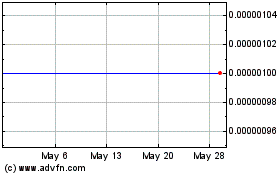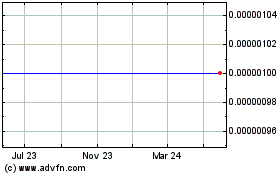Major Gold Producers Reported Reserves of 719.7 Million Ounces (Over 22,000 Tonnes) in 2005; AZHA-ZNXT Mining Briefly Discusses
April 24 2009 - 12:15PM
Marketwired
AZHA Mining (formerly ZNext Mining Industries, Inc.) (PINKSHEETS:
ZNXT) (OTC Preferred: ZNXPP) received its CUSIP # 05477T 109 &
ISIN # US05477T 1097. Stock Symbol will soon follow when all the
required documents by FINRA MDI NASDAQ have been fully submitted.
Please note that Dividends Distribution are given only to ZNXT
Mining Common Shareholders of April 20, 2009 Record date. These
AZHA Mining Dividends are NOT a Forward Split nor are they a
REVERSE Split. The ratio is that for every 50 ZNXT Common, a total
of 75 AZHA Common shares are to be issued to the ZNXT beneficial
common shareholders of record as of April 20, 2009. The 75 AZHA
Mining Common Shares are appropriated as follows: 25 Un-Restricted
(Free Trading) and 50 Restricted of AZHA Common Shares; this is in
addition to their ZNXT holdings that will be converted
automatically to AZHA common stocks.
AZHA is hopeful that as soon as the dust settles during this
re-organization, the shareholders should start receiving or seeing
the dividends to show within 2-3 weeks and that all updates on the
PINKS OTC information will soon be posted in a timely manner.
CEO George Carpio understands the immense challenges ahead as he
assures optimism that he can steer the ZNEXT Mining out of its
mining dormancy due to various obstacles such as environmental
factors, permitting issues and most of all the economic meltdown in
which the company has been stalled. He further believes that the
new management team members have plenty going to get the job done.
The shareholders need to be reassured that to restructure this
governance of the mining operation plans with AZHA's preferred
approach are applied. AZHA will do whatever it can to bring this
mining company into production and profitability. AZHA is hopeful
that the company's ultimate goal would be just at hand.
Mining can be a wonderful and profitable business when it's on
the upside, particularly when the business plan is properly
structured. To start with, AZHA discusses a brief overview and
understanding of gold mining and production.
-- HOW GOLD IS PRODUCED? Gold mining is an intensive process that
requires careful and responsible management The process of
producing gold (from both underground and surface operations) can be
divided into six main phases: (1) finding the ore body; (2) creating
access to the ore body;(3) removing the ore by mining or breaking the
ore body; (4) transporting the broken material from the mining face to
the processing plant for treatment; (5) gold processing; and (6)
refining to 99.999%. For further details, please visit
www.trustingold.com
-- SMALL SCALE MINING -- PANNING Wide shallow pans are filled with sand
and gravel that may contain the rock and other material (because gold
is denser than rock, it quickly settles to the bottom). The silt is
usually taken from a stream bed, often at the bend of the stream, or
from the bedrock, where the weight of gold causes it to settle out of
the water flow.
-- LARGE SCALE MINING: Finding the ore body -- global or regional,
geological exploration programme identifies targets and undertakes
exploration.
(1) OPEN PIT MINING: In open-pit mining, drilling and blasting is
generally needed to release the gold bearing rock. Excavators then
load the material onto the ore transport system.
(2) UNDERGROUND MINING: In underground mining, holes are drilled in
the ore body, filled with explosive and blasted. The blasted
'stopes' or 'faces' are cleaned before the ore is released, ready
for transportation out of the mine. Underground mining methods are
far more variable than open pit mining. The approach used must be
the most cost effective one that fits in with the configuration of
the ore zones, the strength of the ore, and the surrounding rock.
-- GOLD PROCESSING: The most common means of recovering gold is the
cyanidation process. Cyanidation involves the leaching of ore in a
strictly controlled alkaline cyanide leach solution, after which the
gold is then re-dissolved, and subsequently smelted into dore bars that
are shipped to the gold refineries. The residual waste rock is then
generally recycled in land-fill landscaping projects, processing and
refining. The dore U bars are further refined to become as close to
pure gold OF 99.99% as possible, in the form of gold bullion bars.
They are then given 'gold' delivery status, the international standard
for quality, providing assurance that they contain the quantity and
purity of gold that has been stamped on them.
COMMON Q & A
WHAT IS THE AVERAGE COST OF MINING PER OUNCE?
The average cost of replacing and producing an ounce of gold
rose to $428/oz in 2005, a ten-year high, according to Metals
Economics Group, based on a study of 18 major gold producing
companies. However, costs vary widely between companies and the
mines themselves.
HOW MUCH GOLD IS STILL UNDERGROUND?
The major gold producers increased their reported reserves to
719.7 million oz or over 22,000 tonnes at the end of 2005,
according to Metals Economics Group. Assuming a 10% recovery loss
when the ore is extracted, this would amount to 14 years of gold
production at 2005's level. In practice the amount of known
resources remains fairly constant over time since the results of
few exploration finds replacement to those resources that are
exploited.
WHAT IS THE AVERAGE GOLD MINING GRADE?
The grade of ore refers to the proportion of gold contained in
the ore of a particular mine and is quoted in grams per tonne
(g/t). The type of mine depends on the depth and grade of the ore.
At a rough estimate, the larger, better quality South African
underground operations are around 8-10 g/t (Anglo gold), while the
marginal South African underground mines run at around 4-6 g/L Many
of the operations elsewhere in the world are open pit mines roughly
at lower grades, from as little as 1 g/t up to around 3-4 g/t. A
more significant piece of information than average gold mining
grade is cost per ounce, which is a combination of grade
(grams/tonne) and operating costs ((USD/tonne).
WHERE IS THE GOLD MINED?
Gold is mined on every Continent, barring Antarctica.
HOW MUCH GOLD HAS BEEN MINED? The best estimates available
suggest that the total, volume of gold ever mined up to the end of
2006 was approximately 158,000 tonnes, of which around 65% has been
mined since 1950.
ABOUT THE COMPANY
AZHA Mining Corporation, Inc. is a mining company engaged in the
exploration, development and commercialization of new and
underdeveloped mine sites, primarily gold, silver and other
precious metals. AZHA Mining was assigned the 100% interest of the
twelve (12) mining claims in British Columbia, Canada.
Additionally, AZHA was assigned the 100% Interests of the PEARL's
Mineral Production Sharing Agreement (MPSA) explorations whose
application registration has been on file in Region V since 2004;
that includes all of PEARL's gold mining exploration, development
and production.
FORWARD STATEMENTS; Forward-looking statements in this release
include statements regarding the Company's projections regarding
gold, silver and precious metals explorations, extractions and
productions in future periods. Penny Stocks are highly speculative
and may be unsuitable for all but very aggressive investors. The
Company disclaims any intention or obligation to update or revise
any forward-looking statements, whether as a result of new
information, future events or otherwise.
CONTACT: Investor Relations: Dennis Bravs Phone: 888-498-0001
E-mail: Email Contact www.AZHAMinining.com (under Construction)
ZNext Mining (CE) (USOTC:ZNXT)
Historical Stock Chart
From Jan 2025 to Feb 2025

ZNext Mining (CE) (USOTC:ZNXT)
Historical Stock Chart
From Feb 2024 to Feb 2025
